Singapore Curry Noodles
This post contains links to affiliate websites, such as Amazon, and we receive an affiliate commission for any purchases made by you using these links. We appreciate your support!
Singapore curry noodles are easy curried noodles with plump shrimp and chicken, great for a weeknight meal! This version uses common ingredients and comes together in about 30 minutes.
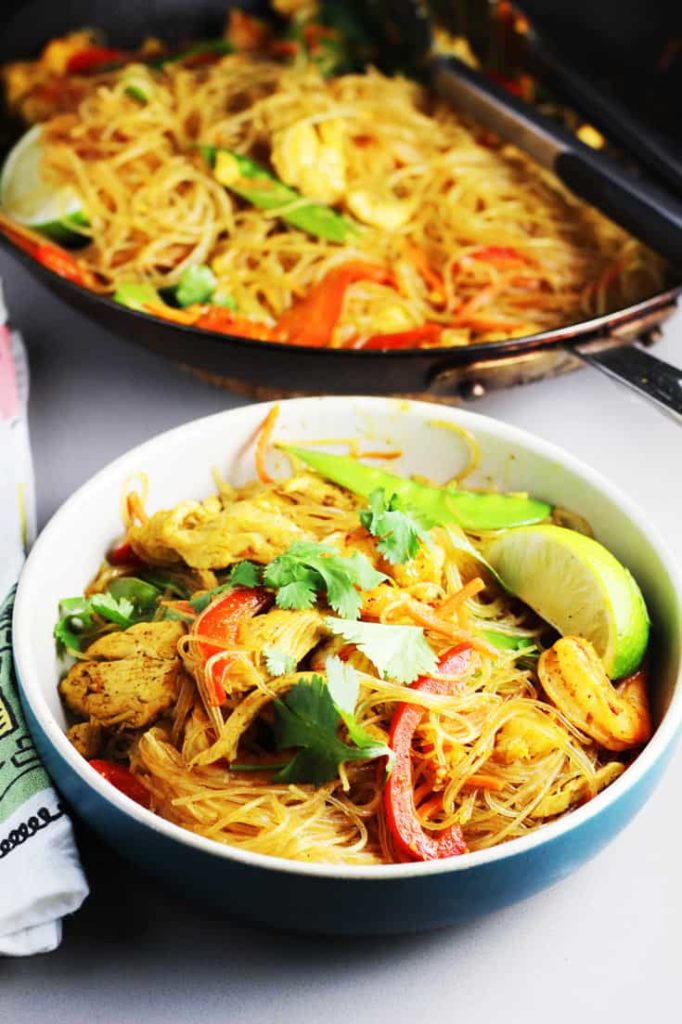
I’ll be honest, sometimes I find stir fry dishes to be a little overly heavy, gloppy, or soy-saucy for my taste. If you’ve never had Singapore curry noodles, they are the opposite of that.
The rice vermicelli noodles keep it light, and the curry sauce just coats without drowning, you know?
There’s also as much veggie, shrimp and chicken as there are noodles, which just keeps the whole thing fresh, colorful and really flavorful. This Singapore noodles recipe is so much better than any takeout, is super customizable because you can add any protein of your choice and it is so easy to prep.
These Singapore curry noodles and this udon stir fry are easily my very favorite Asian noodle dishes.
What are Singapore Noodles?
Unlike what you might assume from the name, Singapore fried noodles were popularized in Hong Kong and are of Cantonese origin, not a Singapore creation at all.
They are a common street food in Hong Kong, and consist of curried vermicelli rice noodles stir-fried with eggs, vegetables and meats – most commonly char siu pork, shrimp and/or chicken.
Ingredient Notes
Rice Vermicelli Noodles
These are thin rice noodles that cook quickly by just soaking in hot water, keeping the dish light. They are also gluten-free!
If you can’t find rice vermicelli at your grocery store, thin wheat noodles or angel hair pasta can be used as alternatives.
Shrimp
I like to use fresh large shrimp in my Singapore curry noodles but you can use frozen as well; just ensure frozen shrimp are completely thawed before cooking. Choose peeled shrimp for convenience.
If you’re not a fan of shrimp, consider substituting with pieces of firm white fish, pork, ham, bacon, or additional chicken. You can also add some scrambled eggs in here for more protein!
Chicken
I like to use boneless, skinless chicken breast as it is ideal for quick cooking. Make sure you slice it thinly for even and fast cooking. You can also use chicken thigh for a juicier flavor.
Carrots
Carrots add a sweet crunch and vibrant color to the Singapore curry noodles. If julienned carrots are too much work, shredded carrots available in bags can be used as a time-saver.
Red Bell Pepper
Use thinly sliced red bell pepper for quick cooking, it adds sweetness and color. Any bell pepper color works, though red offers a nice sweetness.
Snow Peas
These add a crisp texture and a mild, sweet flavor. Sugar snap peas or green beans could be used as alternatives.
These are all the veggies I use – but you are free to add any you like! Some bean sprouts, shallots, celery, or even cabbage would taste good and will add a nice texture.
Lime Juice
The lime juice adds a fresh, acidic element to balance the all the flavors. If lime is not available, lemon juice or rice wine vinegar can work as a substitute.
Soy sauce
Soy sauce provides the salty, umami flavor foundational to many Asian dishes. For a gluten-free option, tamari or coconut aminos are suitable substitutes.
Vegetable oil
You need some vegetable oil for frying; it’s neutral and handles high heat well. Canola or peanut oil are good alternatives.
Garlic & Ginger
Use fresh garlic and ginger for the best flavor! You can chop or mince by hand with a sharp nice or use a tool.
Curry Powder
These are Singapore curry noodles, so of course they need some curry powder! Choose a mild or hot curry powder depending on your heat preference.
Step by Step Instructions
- Remove shells from the shrimp (you can use either frozen and thawed or fresh shrimp).
- Thinly slice the chicken breast into strips.
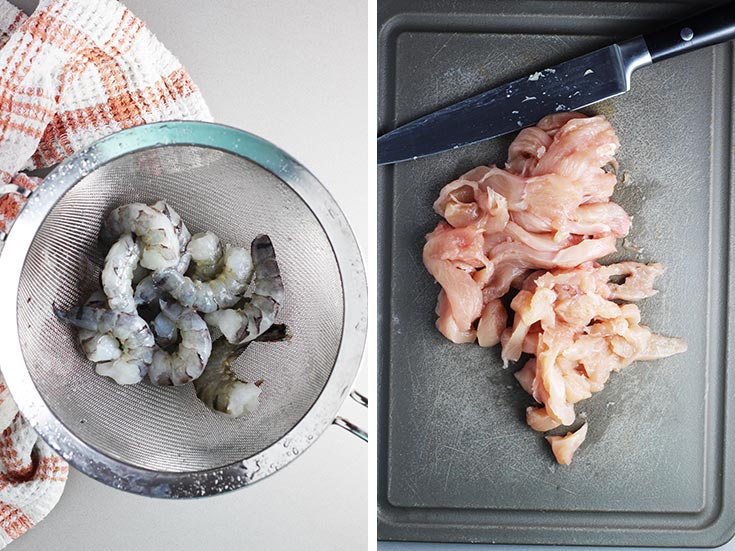
3. Slice some red bell peppers, mince some garlic, julienne some carrots. (Do you have one of these nifty julienne peelers? Very handy.)
4. Whisk together the sauce ingredients: lime juice, soy sauce, water, and 2 tablespoons of vegetable oil.
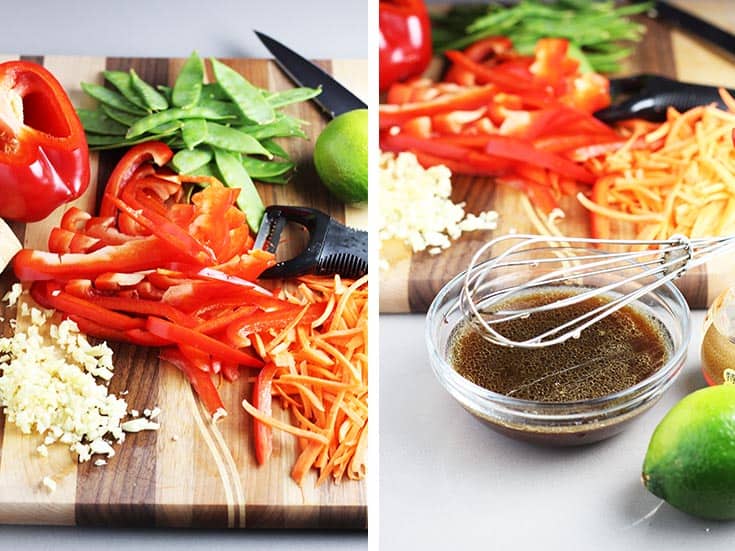
5. Soak the vermicelli noodles in hot water according to package until tender. Drain and set aside.
6. Heat a tablespoon of vegetable oil in a nonstick skillet over high heat, and stir fry the chicken until cooked through.
7. Add the veggies, shrimp, curry powder, ginger and garlic to the pan and cook until vegetables are tender.
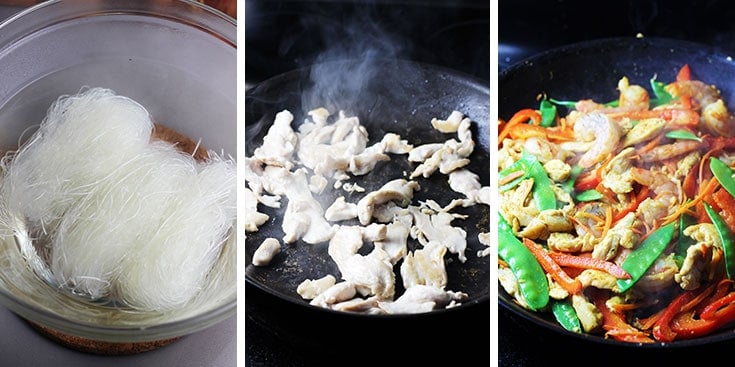
8. Add the drained noodles and pour the sauce in the pan and toss until well combined. Garnish with sliced green onions, cilantro (if desired) and lime slices, and serve.
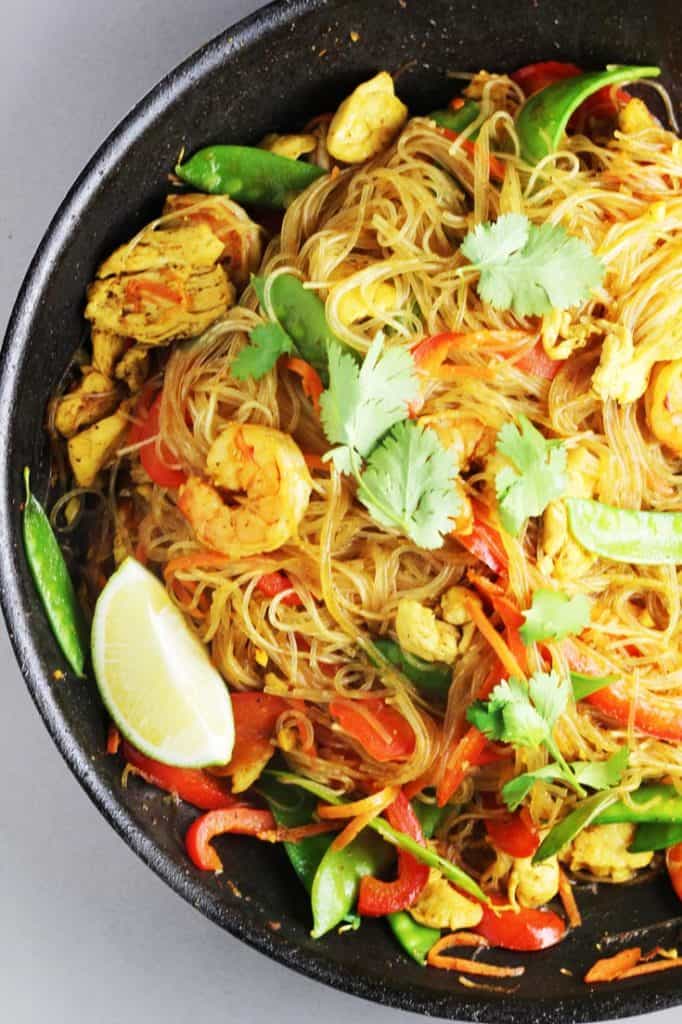
This makes 2-3 generous portions. You could increase the ingredients a bit to feed 4, but it may be a bit difficult to fit everything in a standard large 12″ skillet.
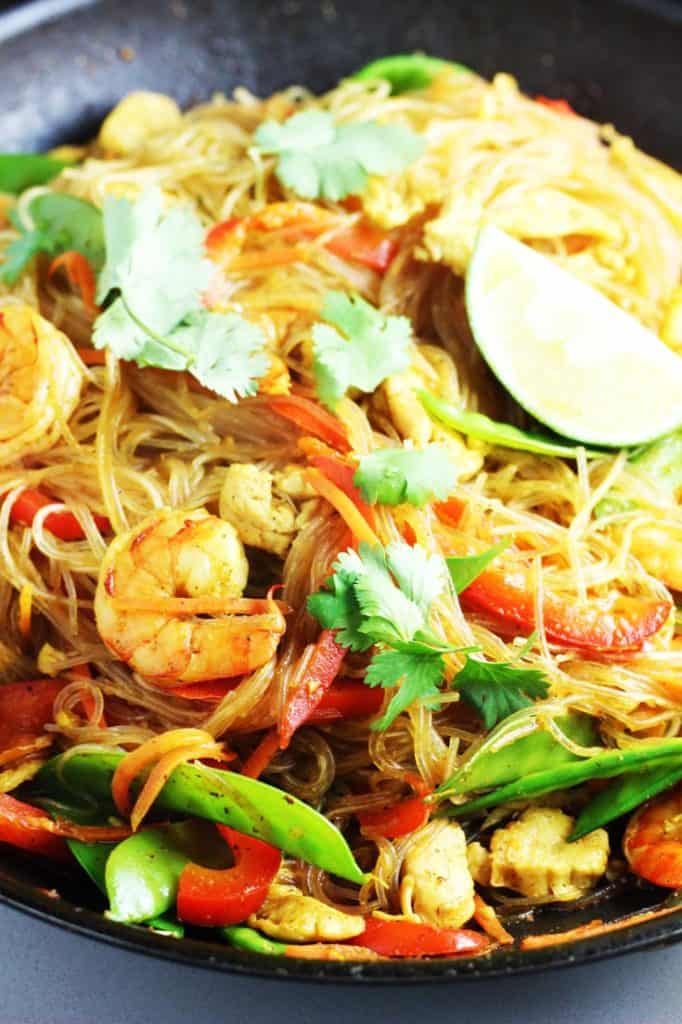
Storage Instructions
Transfer the cooled noodles to an airtight container. Properly stored, these Singapore curry noodles can last in the refrigerator for up to 3-4 days. It’s generally not recommended to freeze this dish as the texture of the vermicelli and vegetables may become mushy upon thawing.
To reheat the noodles, sprinkle a few tablespoons of water over them to help prevent drying out. You can then microwave them on medium power, stirring occasionally until heated through. Alternatively, reheat in a nonstick skillet over medium heat, adding a little oil or water to keep the noodles moist.
A Few More Easy Asian-Inspired Recipes
Spicy, sweet and sticky Sriracha Meatballs
Asian Chicken Salad with Sriracha Peanut Dressing
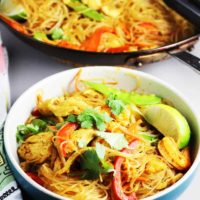
Singapore Noodles
Ingredients
- 5 oz rice vermicelli
- 8 oz peeled raw shrimp fresh or frozen and thawed
- 1 skinless, boneless, chicken breast
- 1 carrot cut into julienne strips
- 1/2 red bell pepper thinly sliced
- 1 cup snow peas
- 3 tablespoons lime juice
- 2 tablespoons soy sauce
- 2 tablespoons water
- 3 tablespoons vegetable oil divided
- 2 clove garlic minced
- 2 teaspoon fresh ginger minced
- 1.5 tablespoons curry powder (more to taste)
- 1 teaspoon kosher salt
- 2 green onions thinly sliced on the bias
- chopped cilantro (optional)
Instructions
- Put shrimp in a colander and rinse under cold running water to thaw. Dry with paper towels.
- Cut chicken breast into thin strips.
- Soak noodles according to package directions. Drain.
- In a small bowl, stir together lime juice, soy sauce, water, and two tablespoons of oil.
- Heat the remaining tablespoon of oil in a non-stick skillet or wok over medium high heat. Add chicken and fry, stirring occasionally until lightly golden.
- Add shrimp, carrot, pepper, garlic, ginger, curry powder, and salt. Stir fry until shrimp turns pink.
- Add the drained noodles and lime juice mixture to the pan. Toss until noodles are hot and bright yellow. Remove from heat and sprinkle with green onions and optional cilantro.

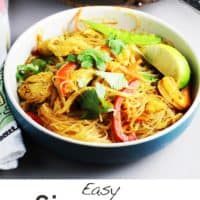
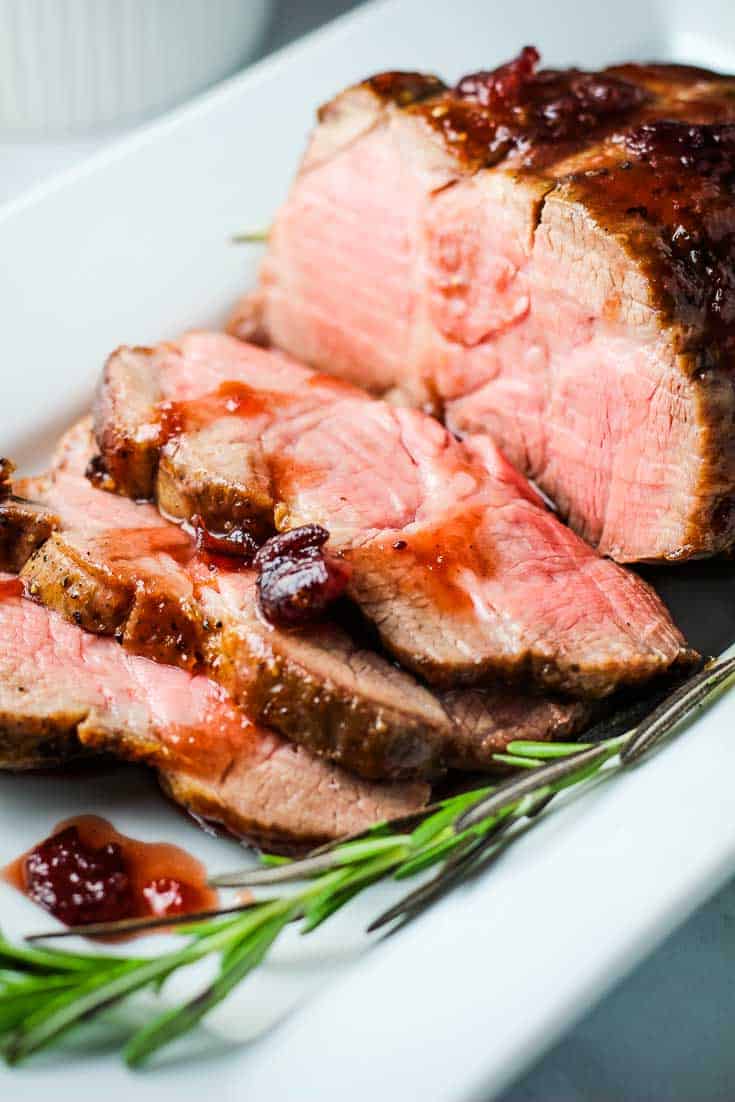
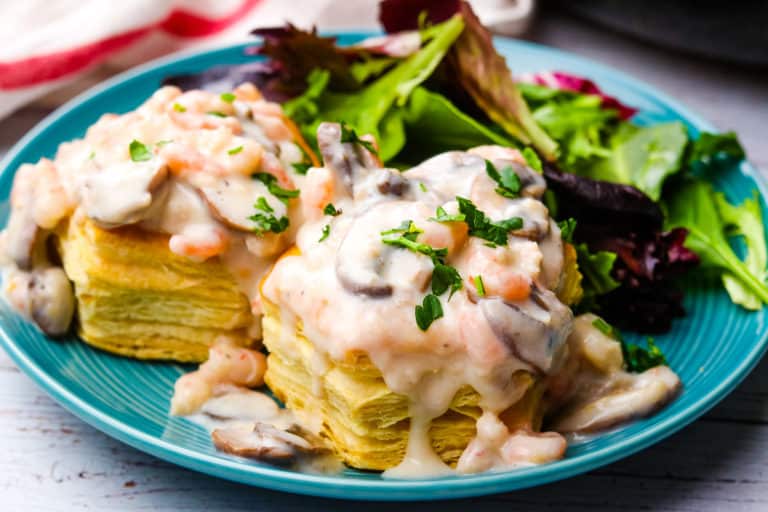
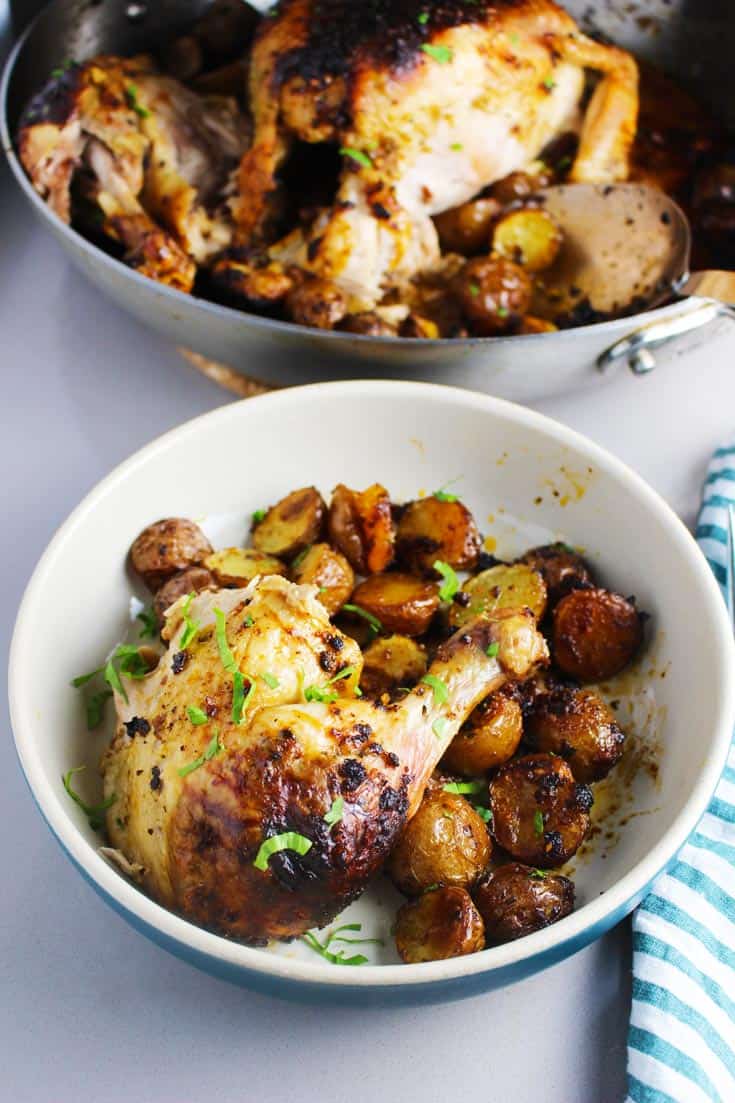

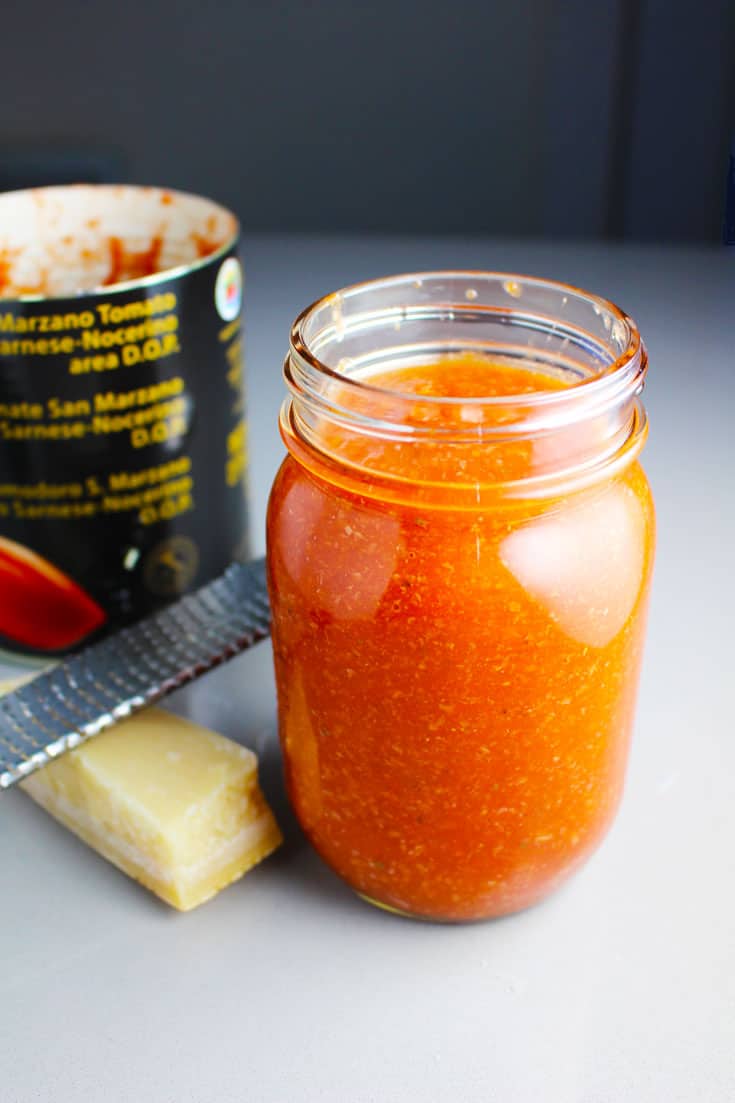
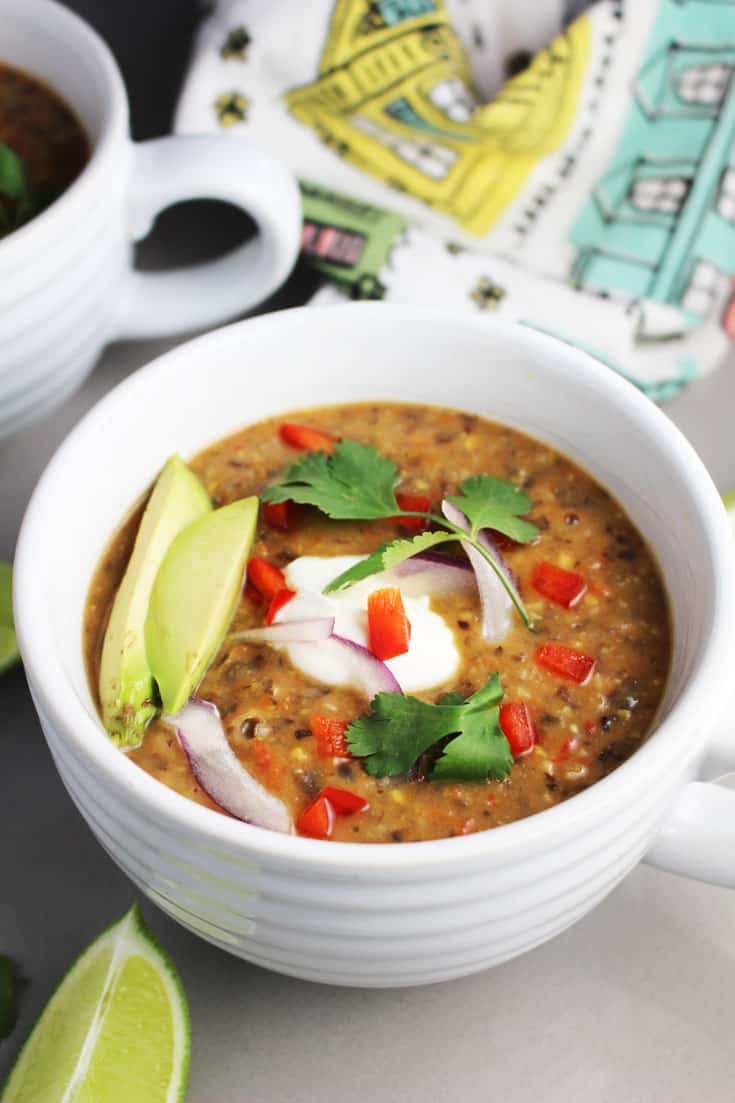
Hi, I made ‘tis tonight. It was very good but a little on the dry side. Any advice?
This is definitely not intended to be a “saucy” stir fry, but tossing with a splash of chicken broth (or water) at the end of cooking should do the trick if your noodles seem too dry 🙂
I appreciate you’ve included this recipe. It’s certainly one of my favorites, and brings back happy memories of our lunches together in Houston! Thanks, sweetheart.
It’s one of my faves and always reminds me of you!